by Jason Bodner
November 21, 2023
Independent thinking is respected, but despite striving to be independent, being with the crowd feels safest, for most. Even though crowds make us feel better, they are not necessarily better for us in the end. In fact, crowds can contort our memories of events, and they can spell disaster when crisis strikes.
Psychologists describe “memory conformity” as how group memories cloud an individual’s ability to recall events clearly. It’s like the game of “telephone.” Even when you hear me tell a story, it’s normal for you to contort what I say when you relay it to another person. Social events are often the most distorted. Given enough reinforcement, you will remember things you never saw and events that never happened.
As if this isn’t enough proof that “crowd think” can hurt you, consider the common misconception of “strength in numbers.” A recent study of 108 teams of volunteers found crisis can taint a crowd. Each team was tasked with deciding how to handle a certain fictitious crisis. Only one individual knew what was going on, but the rest had to talk it out. Invariably, the crowd devolved into unfounded speculation. This caused rumor and innuendo. The bigger the group, the more they sought reassurance, while they also stifled any opinions contrary to the group. This study showed that the group often just stayed paralyzed in their crisis when evacuation was warranted. In essence, strength in numbers led to “analysis paralysis.”
One needn’t look too far to find real life examples. I submit to you the month of October this year, when the stock market was, at least in part, dragged down by paralyzing group think. Of course, the media is often the ringleader when such things happen – and I believe this time was no exception. Throughout most of October, we talked ourselves into a crisis, led by negativity, fear and uncertainty. Sound familiar?
What a difference a day (and month) makes, because as October came to a close, November saw stocks blossoming. Oversold talk flipped to overbought. Selling the peaks turned into buying the dips. This all happened at such breakneck speeds that it made me wonder: “Where did all the bears go?”
This was an inside joke at my research firm. When people get bearish, they love to find reassurance with fellow bears, even in our firm. And the worse things got, the louder they got! Then suddenly, relief came, out of the blue – in late October. And the bear growls just stopped. Where did all the bears go?
In a word, the bears went into hibernation, apparently starting over the weekend of October 28-29.
The latest economic data has all but assured us that the Fed has stopped raising rates. The Fed funds watch probability of no further hikes rose from 85% to 100% last Tuesday, the day the latest CPI data came out. The market screamed higher, led by growth and small caps.
Do you want to see how quickly bears can go into hibernation? Let’s look at some charts.
First, we see the Big Money Index (BMI) vaulting north out of its oversold condition – just as I said it would. From a low of 17.4% on October 30th, we’ve risen to 36.1% on November 16th. And with that came a rally of 9.6% in the SPY (the S&P 500 ETF) since its October 27th’s low:

Graphs are for illustrative and discussion purposes only. Please read important disclosures at the end of this commentary.
For clarity on these charts, the bears are in red. And in the next two charts you can literally see them scurrying away at top speed. When the market lows were put in, the bears were at their peak, selling everything they could. Then, suddenly, the red gave way to green, indicating new bulls.
You can see this pattern in both the charts of Big Money Buying for stocks and ETFs:
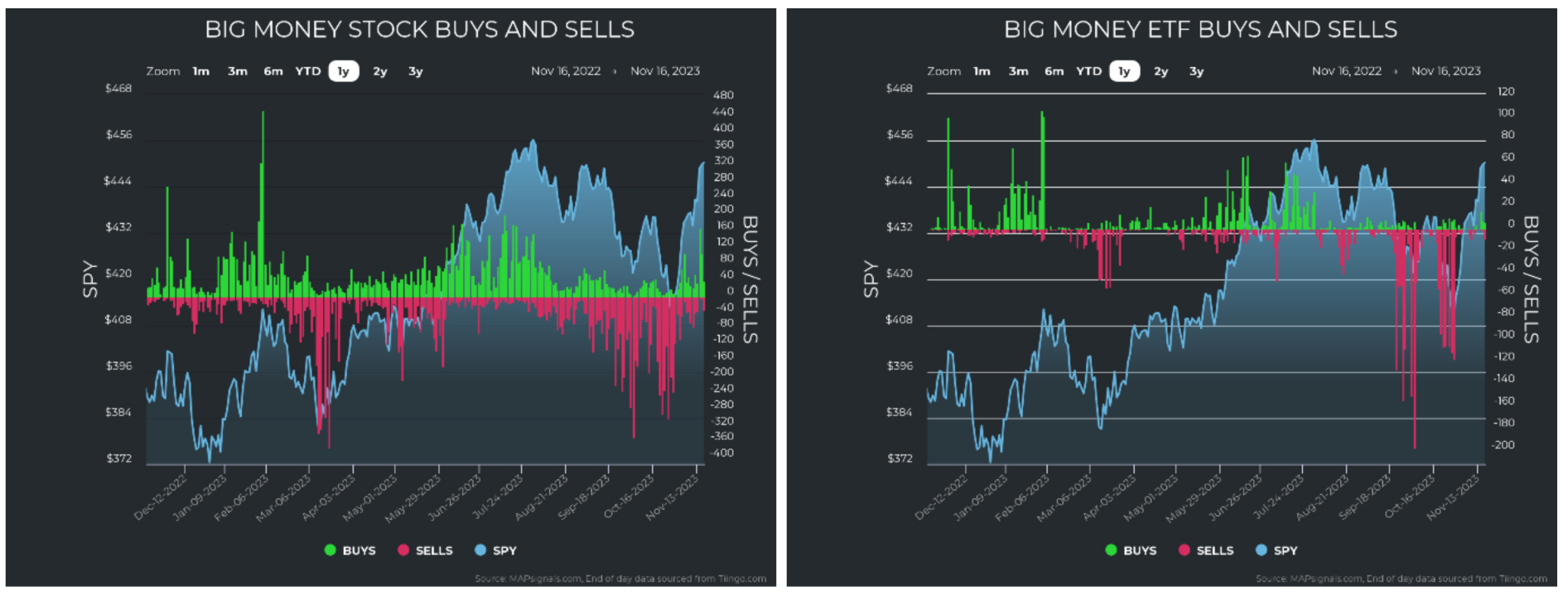
Graphs are for illustrative and discussion purposes only. Please read important disclosures at the end of this commentary.
And just to let you know that the volumes were immense on the upside rally, the next chart shows you each day’s cumulative trades of unusual volume (in amber yellow). Normally, huge bearish action sees a ton of volume, just like October. But we also notice that November volumes have been very big, with a pause when the market paused briefly. The rally has been stunning, on big volume, scattering the bears:
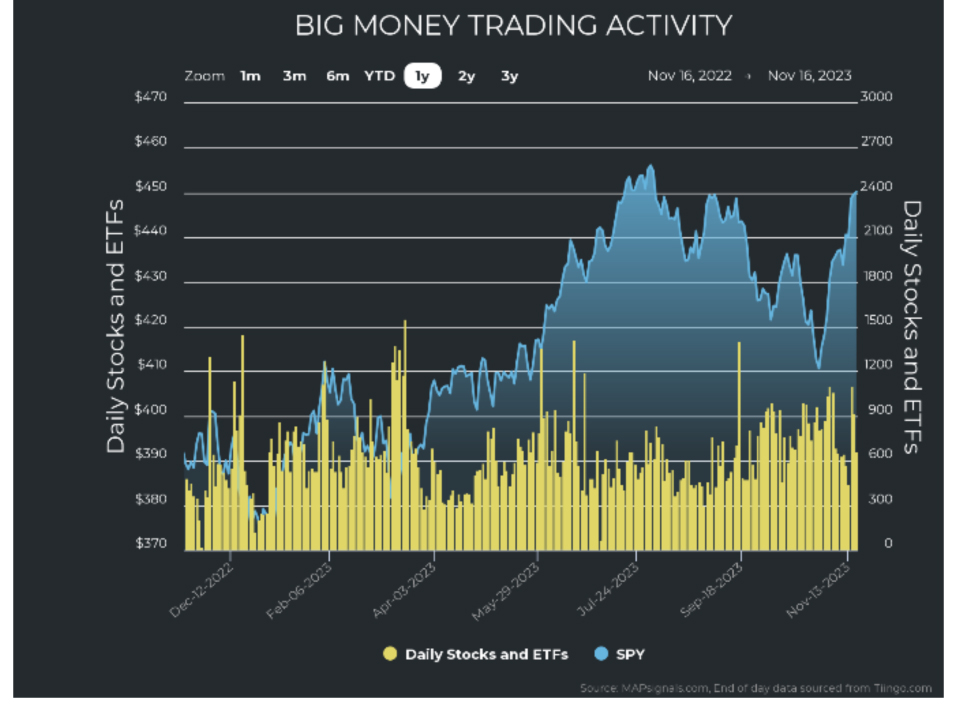
Graphs are for illustrative and discussion purposes only. Please read important disclosures at the end of this commentary.
What is also interesting is to see that small- and mid-caps have been scooped up in huge amounts.
In the following chart, we see unusual buying for November thus far, distributed by market cap categories. You can see how much buying has taken place in the smaller stocks:
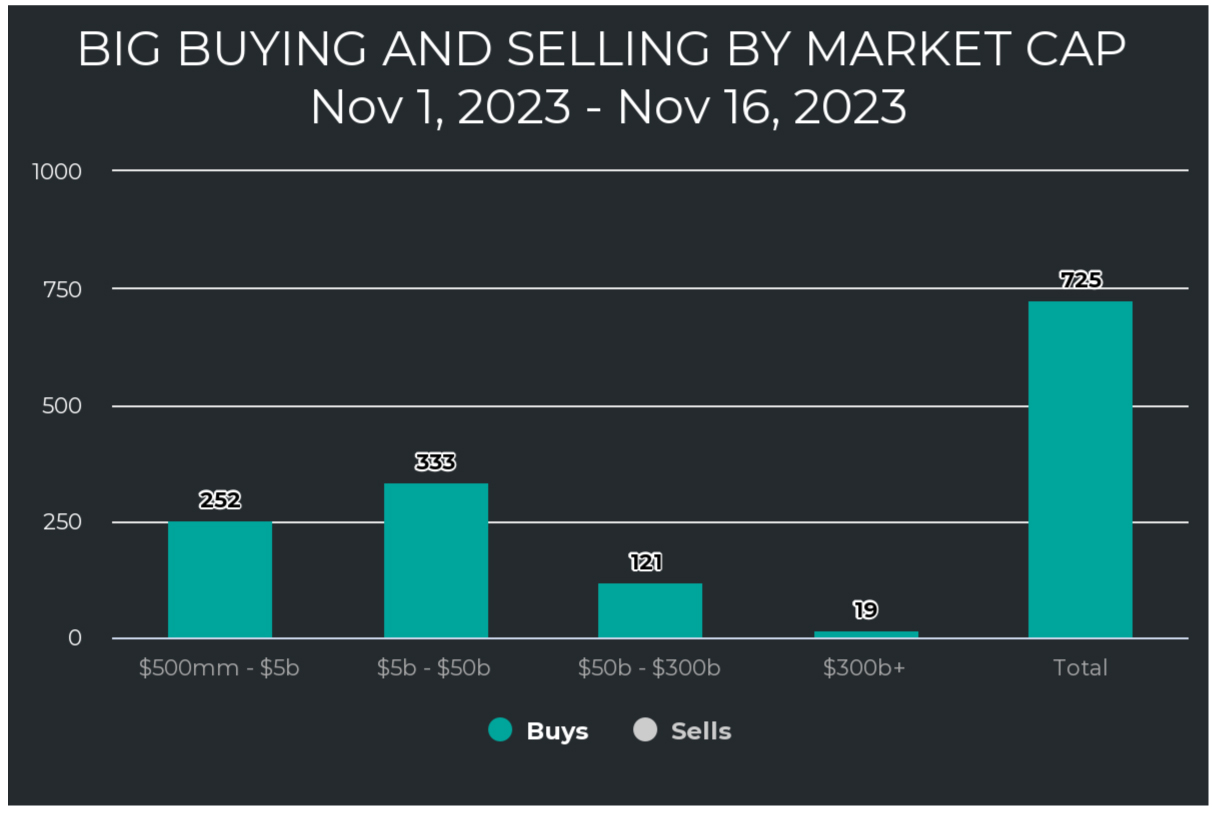
Graphs are for illustrative and discussion purposes only. Please read important disclosures at the end of this commentary.
Now for the fun part: What sectors are leading us higher? For much of the sloppy summer, energy was the only sector propping us up. Energy had strength, while most everything else had weakness.
Now, suddenly, tech and discretionary sectors have overtaken energy on the ranking list:
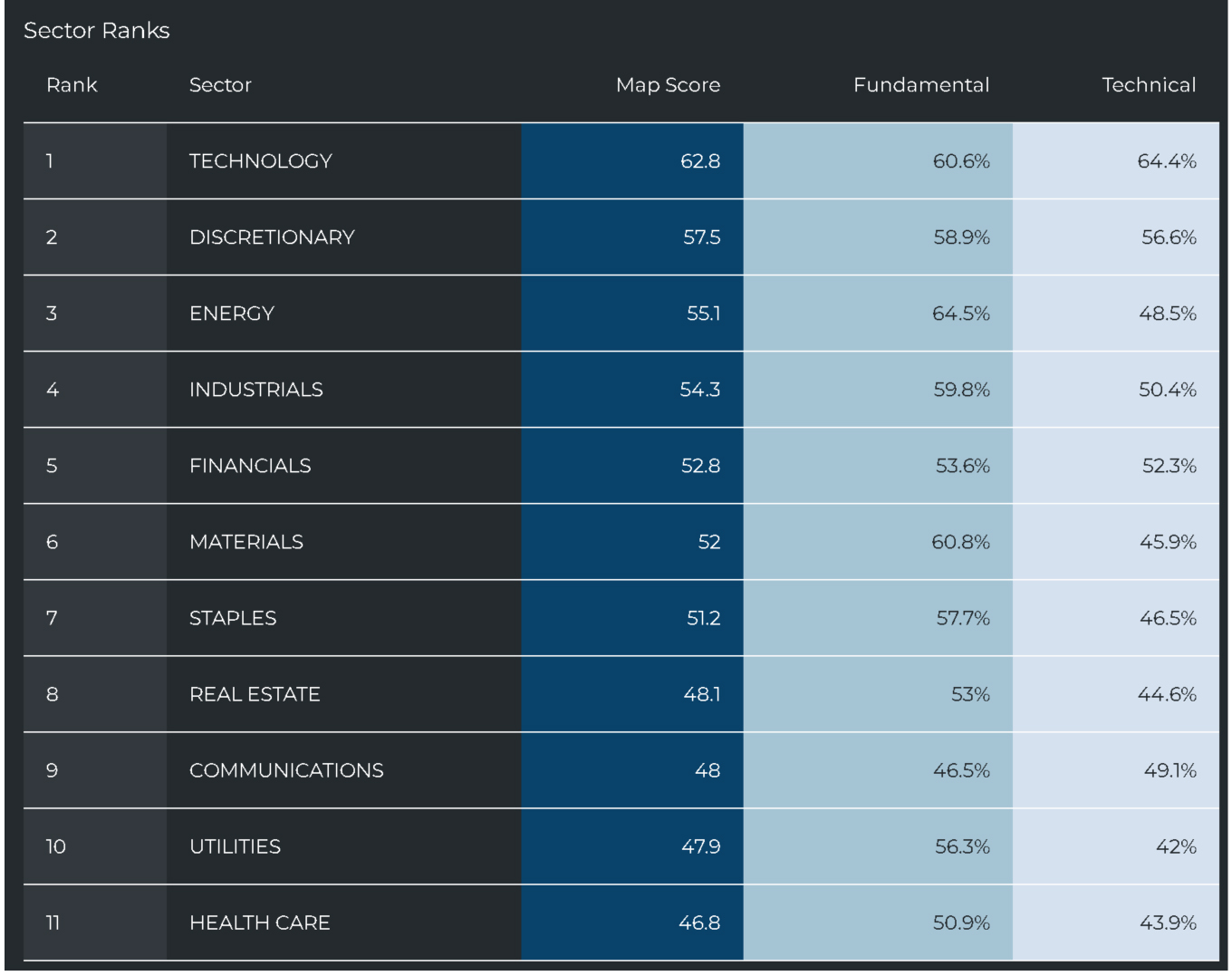
Graphs are for illustrative and discussion purposes only. Please read important disclosures at the end of this commentary.
We see runner-up support by industrials, financials, and materials. We can see how that breaks down when we look at the individual sector buying and selling. Technicals and discretionary saw notable buying, while energy saw recent distribution. Energy is the only sector that saw November selling.

Graphs are for illustrative and discussion purposes only. Please read important disclosures at the end of this commentary.
We can see little green shoots in all the remaining sectors:


Graphs are for illustrative and discussion purposes only. Please read important disclosures at the end of this commentary.
What really stands out in red is that utilities went oversold in late September and early October.
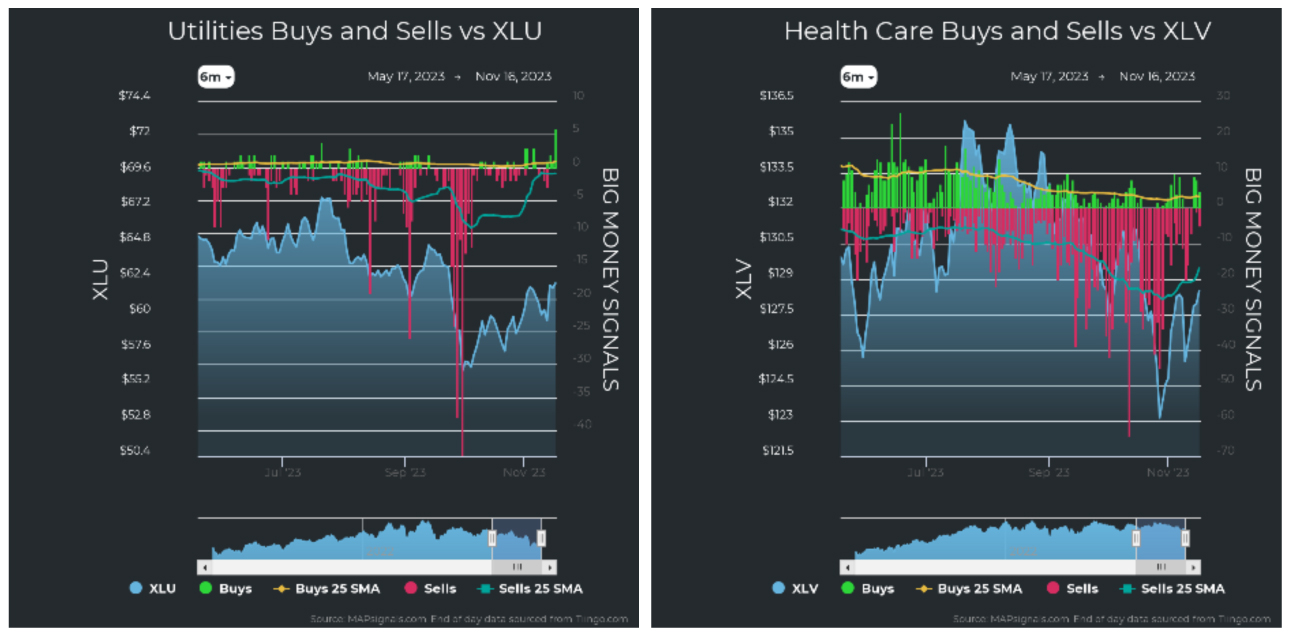
Graphs are for illustrative and discussion purposes only. Please read important disclosures at the end of this commentary.
The tide has turned for stocks. Seasonally strong November and December are here. Rate hikes are done, and cuts may be closer than we think. Either way, it’s time to stop worrying. The bears are snoring.
Oscar Wilde said: “Some cause happiness wherever they go. Some whenever they go.” Like bears.
All content above represents the opinion of Jason Bodner of Navellier & Associates, Inc.
Also In This Issue
A Look Ahead by Louis Navellier
Consumer Inflation is Fading Fast – and Producer Prices Turned Negative
Income Mail by Bryan Perry
A Technical Take on Where Mr. Market Stands Now
Growth Mail by Gary Alexander
The Market Shrugged Off the Worst Shocks of the Last Century
Global Mail by Ivan Martchev
The Stock Market is Pushing Against Statistical Extremes
Sector Spotlight by Jason Bodner
Where Did All October’s Bears Go (After Halloween)?
View Full Archive
Read Past Issues Here

Jason Bodner
MARKETMAIL EDITOR FOR SECTOR SPOTLIGHT
Jason Bodner writes Sector Spotlight in the weekly Marketmail publication and has authored several white papers for the company. He is also Co-Founder of Macro Analytics for Professionals which produces proprietary equity accumulation/distribution research for its clients. Previously, Mr. Bodner served as Director of European Equity Derivatives for Cantor Fitzgerald Europe in London, then moved to the role of Head of Equity Derivatives North America for the same company in New York. He also served as S.V.P. Equity Derivatives for Jefferies, LLC. He received a B.S. in business administration in 1996, with honors, from Skidmore College as a member of the Periclean Honors Society. All content of “Sector Spotlight” represents the opinion of Jason Bodner
Important Disclosures:
Jason Bodner is a co-founder and co-owner of Mapsignals. Mr. Bodner is an independent contractor who is occasionally hired by Navellier & Associates to write an article and or provide opinions for possible use in articles that appear in Navellier & Associates weekly Market Mail. Mr. Bodner is not employed or affiliated with Louis Navellier, Navellier & Associates, Inc., or any other Navellier owned entity. The opinions and statements made here are those of Mr. Bodner and not necessarily those of any other persons or entities. This is not an endorsement, or solicitation or testimonial or investment advice regarding the BMI Index or any statements or recommendations or analysis in the article or the BMI Index or Mapsignals or its products or strategies.
Although information in these reports has been obtained from and is based upon sources that Navellier believes to be reliable, Navellier does not guarantee its accuracy and it may be incomplete or condensed. All opinions and estimates constitute Navellier’s judgment as of the date the report was created and are subject to change without notice. These reports are for informational purposes only and are not a solicitation for the purchase or sale of a security. Any decision to purchase securities mentioned in these reports must take into account existing public information on such securities or any registered prospectus.To the extent permitted by law, neither Navellier & Associates, Inc., nor any of its affiliates, agents, or service providers assumes any liability or responsibility nor owes any duty of care for any consequences of any person acting or refraining to act in reliance on the information contained in this communication or for any decision based on it.
Past performance is no indication of future results. Investment in securities involves significant risk and has the potential for partial or complete loss of funds invested. It should not be assumed that any securities recommendations made by Navellier. in the future will be profitable or equal the performance of securities made in this report. Dividend payments are not guaranteed. The amount of a dividend payment, if any, can vary over time and issuers may reduce dividends paid on securities in the event of a recession or adverse event affecting a specific industry or issuer.
None of the stock information, data, and company information presented herein constitutes a recommendation by Navellier or a solicitation to buy or sell any securities. Any specific securities identified and described do not represent all of the securities purchased, sold, or recommended for advisory clients. The holdings identified do not represent all of the securities purchased, sold, or recommended for advisory clients and the reader should not assume that investments in the securities identified and discussed were or will be profitable.
Information presented is general information that does not take into account your individual circumstances, financial situation, or needs, nor does it present a personalized recommendation to you. Individual stocks presented may not be suitable for every investor. Investment in securities involves significant risk and has the potential for partial or complete loss of funds invested. Investment in fixed income securities has the potential for the investment return and principal value of an investment to fluctuate so that an investor’s holdings, when redeemed, may be worth less than their original cost.
One cannot invest directly in an index. Index is unmanaged and index performance does not reflect deduction of fees, expenses, or taxes. Presentation of Index data does not reflect a belief by Navellier that any stock index constitutes an investment alternative to any Navellier equity strategy or is necessarily comparable to such strategies. Among the most important differences between the Indices and Navellier strategies are that the Navellier equity strategies may (1) incur material management fees, (2) concentrate its investments in relatively few stocks, industries, or sectors, (3) have significantly greater trading activity and related costs, and (4) be significantly more or less volatile than the Indices.
ETF Risk: We may invest in exchange traded funds (“ETFs”) and some of our investment strategies are generally fully invested in ETFs. Like traditional mutual funds, ETFs charge asset-based fees, but they generally do not charge initial sales charges or redemption fees and investors typically pay only customary brokerage fees to buy and sell ETF shares. The fees and costs charged by ETFs held in client accounts will not be deducted from the compensation the client pays Navellier. ETF prices can fluctuate up or down, and a client account could lose money investing in an ETF if the prices of the securities owned by the ETF go down. ETFs are subject to additional risks:
- ETF shares may trade above or below their net asset value;
- An active trading market for an ETF’s shares may not develop or be maintained;
- The value of an ETF may be more volatile than the underlying portfolio of securities the ETF is designed to track;
- The cost of owning shares of the ETF may exceed those a client would incur by directly investing in the underlying securities; and
- Trading of an ETF’s shares may be halted if the listing exchange’s officials deem it appropriate, the shares are delisted from the exchange, or the activation of market-wide “circuit breakers” (which are tied to large decreases in stock prices) halts stock trading generally.
Grader Disclosures: Investment in equity strategies involves substantial risk and has the potential for partial or complete loss of funds invested. The sample portfolio and any accompanying charts are for informational purposes only and are not to be construed as a solicitation to buy or sell any financial instrument and should not be relied upon as the sole factor in an investment making decision. As a matter of normal and important disclosures to you, as a potential investor, please consider the following: The performance presented is not based on any actual securities trading, portfolio, or accounts, and the reported performance of the A, B, C, D, and F portfolios (collectively the “model portfolios”) should be considered mere “paper” or pro forma performance results based on Navellier’s research.
Investors evaluating any of Navellier & Associates, Inc.’s, (or its affiliates’) Investment Products must not use any information presented here, including the performance figures of the model portfolios, in their evaluation of any Navellier Investment Products. Navellier Investment Products include the firm’s mutual funds and managed accounts. The model portfolios, charts, and other information presented do not represent actual funded trades and are not actual funded portfolios. There are material differences between Navellier Investment Products’ portfolios and the model portfolios, research, and performance figures presented here. The model portfolios and the research results (1) may contain stocks or ETFs that are illiquid and difficult to trade; (2) may contain stock or ETF holdings materially different from actual funded Navellier Investment Product portfolios; (3) include the reinvestment of all dividends and other earnings, estimated trading costs, commissions, or management fees; and, (4) may not reflect prices obtained in an actual funded Navellier Investment Product portfolio. For these and other reasons, the reported performances of model portfolios do not reflect the performance results of Navellier’s actually funded and traded Investment Products. In most cases, Navellier’s Investment Products have materially lower performance results than the performances of the model portfolios presented.
This report contains statements that are, or may be considered to be, forward-looking statements. All statements that are not historical facts, including statements about our beliefs or expectations, are “forward-looking statements” within the meaning of The U.S. Private Securities Litigation Reform Act of 1995. These statements may be identified by such forward-looking terminology as “expect,” “estimate,” “plan,” “intend,” “believe,” “anticipate,” “may,” “will,” “should,” “could,” “continue,” “project,” or similar statements or variations of such terms. Our forward-looking statements are based on a series of expectations, assumptions, and projections, are not guarantees of future results or performance, and involve substantial risks and uncertainty as described in Form ADV Part 2A of our filing with the Securities and Exchange Commission (SEC), which is available at www.adviserinfo.sec.gov or by requesting a copy by emailing info@navellier.com. All of our forward-looking statements are as of the date of this report only. We can give no assurance that such expectations or forward-looking statements will prove to be correct. Actual results may differ materially. You are urged to carefully consider all such factors.
FEDERAL TAX ADVICE DISCLAIMER: As required by U.S. Treasury Regulations, you are informed that, to the extent this presentation includes any federal tax advice, the presentation is not written by Navellier to be used, and cannot be used, for the purpose of avoiding federal tax penalties. Navellier does not advise on any income tax requirements or issues. Use of any information presented by Navellier is for general information only and does not represent tax advice either express or implied. You are encouraged to seek professional tax advice for income tax questions and assistance.
IMPORTANT NEWSLETTER DISCLOSURE:The hypothetical performance results for investment newsletters that are authored or edited by Louis Navellier, including Louis Navellier’s Growth Investor, Louis Navellier’s Breakthrough Stocks, Louis Navellier’s Accelerated Profits, and Louis Navellier’s Platinum Club, are not based on any actual securities trading, portfolio, or accounts, and the newsletters’ reported hypothetical performances should be considered mere “paper” or proforma hypothetical performance results and are not actual performance of real world trades. Navellier & Associates, Inc. does not have any relation to or affiliation with the owner of these newsletters. There are material differences between Navellier Investment Products’ portfolios and the InvestorPlace Media, LLC newsletter portfolios authored by Louis Navellier. The InvestorPlace Media, LLC newsletters contain hypothetical performance that do not include transaction costs, advisory fees, or other fees a client might incur if actual investments and trades were being made by an investor. As a result, newsletter performance should not be used to evaluate Navellier Investment services which are separate and different from the newsletters. The owner of the newsletters is InvestorPlace Media, LLC and any questions concerning the newsletters, including any newsletter advertising or hypothetical Newsletter performance claims, (which are calculated solely by Investor Place Media and not Navellier) should be referred to InvestorPlace Media, LLC at (800) 718-8289.
Please note that Navellier & Associates and the Navellier Private Client Group are managed completely independent of the newsletters owned and published by InvestorPlace Media, LLC and written and edited by Louis Navellier, and investment performance of the newsletters should in no way be considered indicative of potential future investment performance for any Navellier & Associates separately managed account portfolio. Potential investors should consult with their financial advisor before investing in any Navellier Investment Product.
Navellier claims compliance with Global Investment Performance Standards (GIPS). To receive a complete list and descriptions of Navellier’s composites and/or a presentation that adheres to the GIPS standards, please contact Navellier or click here. It should not be assumed that any securities recommendations made by Navellier & Associates, Inc. in the future will be profitable or equal the performance of securities made in this report.
FactSet Disclosure: Navellier does not independently calculate the statistical information included in the attached report. The calculation and the information are provided by FactSet, a company not related to Navellier. Although information contained in the report has been obtained from FactSet and is based on sources Navellier believes to be reliable, Navellier does not guarantee its accuracy, and it may be incomplete or condensed. The report and the related FactSet sourced information are provided on an “as is” basis. The user assumes the entire risk of any use made of this information. Investors should consider the report as only a single factor in making their investment decision. The report is for informational purposes only and is not intended as an offer or solicitation for the purchase or sale of a security. FactSet sourced information is the exclusive property of FactSet. Without prior written permission of FactSet, this information may not be reproduced, disseminated or used to create any financial products. All indices are unmanaged and performance of the indices include reinvestment of dividends and interest income, unless otherwise noted, are not illustrative of any particular investment and an investment cannot be made in any index. Past performance is no guarantee of future results.
